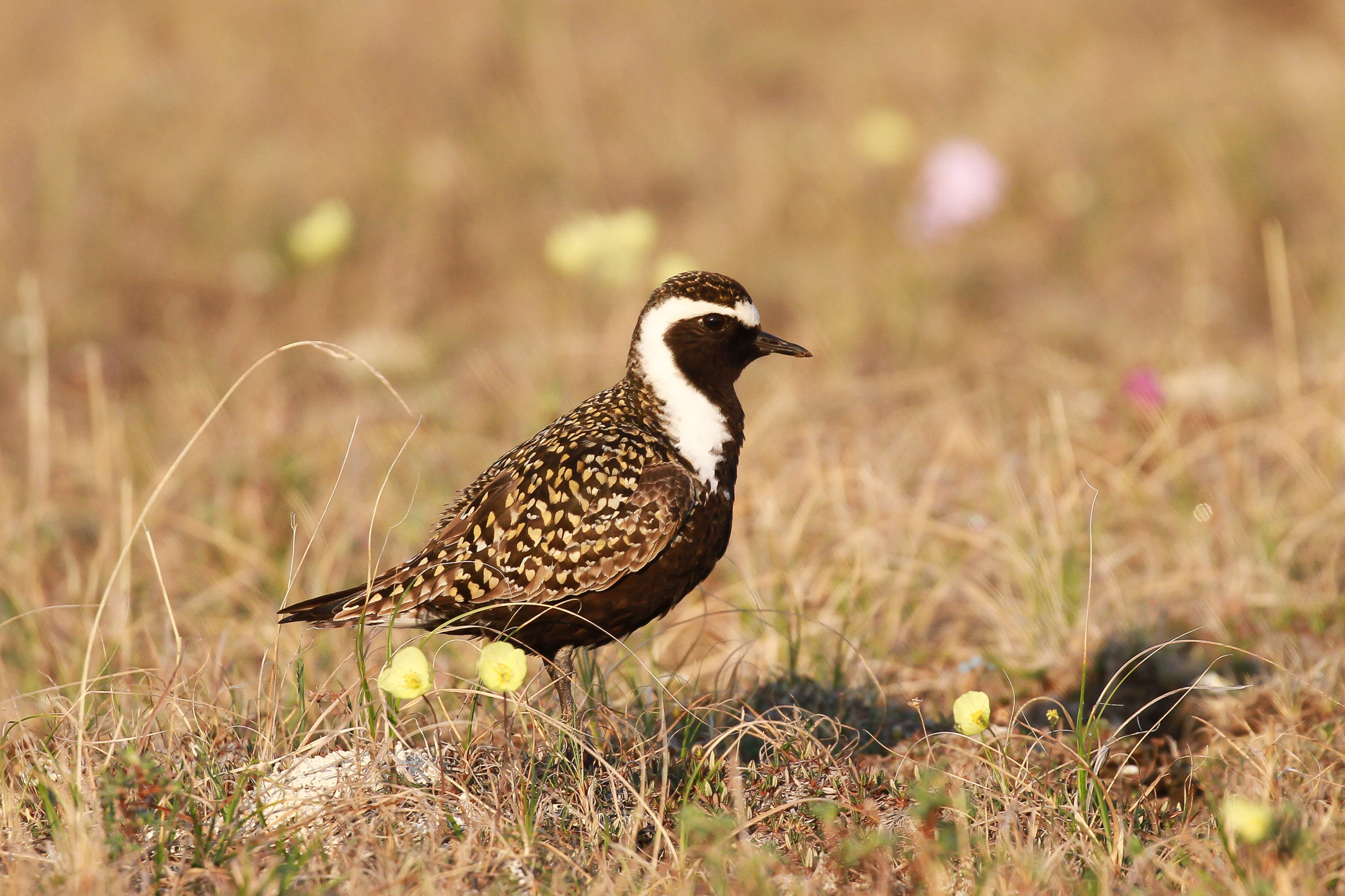By Abby N. Powell and Colleen M. Handel
Linked paper: Does habitat partitioning by sympatric plovers affect nest survival? by K.S. Overduijn, C.M. Handel, and A.N. Powell, The Auk: Ornithological Advances.
If you were searching for a summer home in which to raise your young family, would you choose a place close to the coast, amidst lush, verdant meadows, or high up in the mountains, with diminutive rock gardens? Would it matter, as long as you had a view? Might your neighbors make a difference? What about safety? Climate change?
In some areas around the Bering Strait, two closely related species of golden-plover breed sympatrically. One such area is in western Alaska on the Seward Peninsula, where American and Pacific golden-plovers (Pluvialis apricaria and P. fulva) nest along an elevational gradient that ranges from coastal tundra meadows to alpine tundra. Red foxes (Vulpes vulpes) are major predators at all elevations, seeking primarily voles and lemmings but also snacking on eggs, chicks, and any adult birds they can catch as they lope along their twisting paths. Plovers of both species prefer to nest in open tundra with an unimpeded view, and they typically sneak away from their camouflaged eggs while a ground predator is still far away. Their piercing alarm calls from a distant hillock grant them special status as sentinels of the Arctic tundra.

In response to a warming climate, shrubs have been steadily encroaching on the tundra, altering these once-open landscapes. We wondered whether one of these plover species might have a competitive edge over the other if and when shrub expansion limits suitable habitat for nesting. To address this, we studied how individuals of both species partitioned the available nesting habitat and whether habitat selection affected their nesting success. We reasoned that elevational gradients may be good stand-ins for the habitat changes projected to occur over time across the birds’ breeding ranges. If directional selection were at play, nest survival would likely be higher among nests of either species at higher elevations with shorter vegetation. Alternatively, nest survival could show an adaptive peak at intermediate values for both plovers, or stabilizing selection could result in different adaptive peaks for each.
Kelly Overduijn tackled this question for her graduate student project. Along with her intrepid troupe of assistants, she spent two summers finding and monitoring plover nests and measuring habitat directly around the nests as well as within the plovers’ breeding territories. Study areas ranged from sea level to 400 meters and encompassed a variety of habitats, ranging from grassy meadows and tall shrubland near the coast, upward along hillsides covered with shorter shrubs and acid-loving tundra plants, and finally up to lichen-dominated alpine meadows and granitic alpine ridges.

Both species selected nest sites with short, sparse vegetation compared to what was typical within their territories, but the two species partitioned nesting along an elevational gradient. Pacific Golden-Plovers generally selected moister, lower elevation habitats, whereas American Golden-Plovers selected rockier areas at higher elevations. Despite these patterns, however, we were surprised to find no differences between species in nest success and no evidence of directional, stabilizing, or adaptive-peak selection. Given that these species have different migratory routes, we initially hypothesized that selection of nest sites might be related to what habitat is available when each species arrives in the spring, but despite marked variability between years in spring temperatures and snowpack, there was no relationship between nest initiation date and elevation for either species in either year.
What could be driving these species to partition their nesting habitat if not survival of nests or breeding phenology? One immediate explanation could be direct competition for nest sites. We, along with other researchers in the area, have observed one-on-one contests between neighboring males of different species. American Golden-Plovers are larger than Pacifics and thus have a competitive edge when it comes to these interactions. Ultimately, competition for more open breeding habitats may be related more to survival of the long-lived plovers’ precocial offspring or the adults themselves than to nest survival.
As shrubs continue to encroach on tundra, Pacific Golden-Plovers may suffer an increasingly greater disadvantage in their use of lower elevations and moister habitats. Shrub expansion is projected to accelerate in areas with greater soil moisture and warmth, such as coastal lowland tundra of western Alaska. Whether we lose Pacific Golden-Plovers there because of climate change remains to be seen. Although it appears that American Golden-Plovers may have a competitive edge despite life-history characteristics very similar to those of Pacifics, both species may have enough behavioral plasticity to adapt to changing habitat conditions. Indeed, a panoramic view, minimal competition with neighbors, and, ultimately, a suitable climate all seem to be important factors when it comes to selecting a summer home. Might parents also be seeking a safe neighborhood with plenty of food to ensure the survival of their offspring? Stay tuned for the next chapter of the story.
